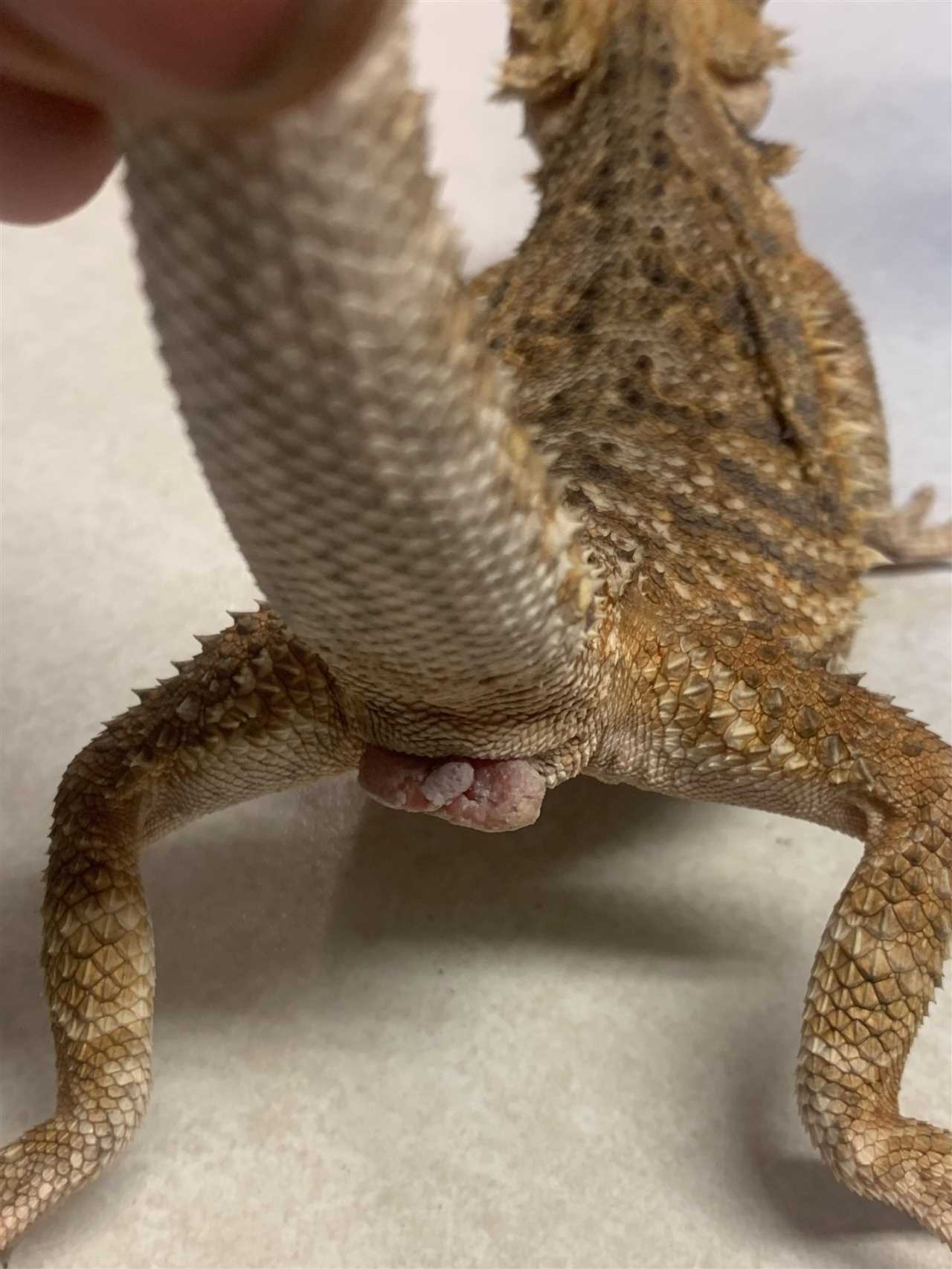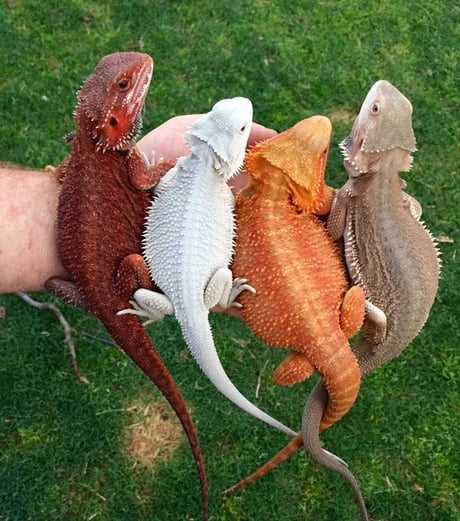The Anatomy of a Bearded Dragon’s Penis
One of the most distinctive features of a male bearded dragon is its hemipenes, which are its reproductive organs. Hemipenes, located at the base of the tail, are two small, flexible, and tubular structures that are responsible for fertilizing the female bearded dragon’s eggs.
The hemipenes are covered in scales, similar to the rest of the bearded dragon’s body. These scales serve as protection and are usually more keratinized compared to the scales on other parts of the body. The appearance and size of the hemipenes can vary depending on the age and size of the bearded dragon.
During sexual arousal or mating, the hemipenes of a male bearded dragon become engorged with blood and protrude from the body. This is a natural and normal behavior for male bearded dragons during the mating process.
How Bearded Dragons Reproduce
1. Mating Season: Bearded dragons have a specific mating season, which typically occurs during the warm months. This is when the males become more active and display their dominance to attract females. During this time, male bearded dragons develop a darker beard and may bob their head or perform a “push-up” motion to show off to potential mates.
2. Copulation: Once a female bearded dragon is receptive to mating, she will allow the male to approach and mount her. The male will grab the female around the neck with his mouth and align his cloaca, which is the opening where both waste and reproductive materials are expelled, with the female’s cloaca for breeding to occur.
3. Egg Laying: After successful copulation, the female bearded dragon will go through a process called oviposition, which is the laying of eggs. Female bearded dragons can lay anywhere from 15 to 30 eggs per clutch, depending on their size and overall health. They will find a suitable nesting spot, usually a burrow or hole in the ground, and dig a shallow hole to deposit their eggs.
5. Hatching: Once the incubation period is complete, the baby bearded dragons will start to hatch. They use a specialized egg-tooth on their snout to break through the shell. The babies are fully independent and will begin exploring their environment and hunting for food shortly after hatching.
Sexing Bearded Dragons
One of the most reliable ways to sex a bearded dragon is by examining the size and shape of their tail base. Male bearded dragons typically have wider and thicker tail bases compared to females. This is because males have a hemipenal bulge located at the base of their tail, which is not present in females. The hemipenal bulge is a noticeable protrusion that is more prominent in sexually mature males.
Another characteristic that can be used to determine the sex of a bearded dragon is the presence of femoral pores. These are small, raised dots that can be found on the undersides of the hind legs. Male bearded dragons typically have more noticeable and larger femoral pores compared to females. These pores secrete a waxy substance and are involved in scent marking and territory defense.
In addition to these physical characteristics, behavioral differences can also provide clues about the sex of a bearded dragon. Males are often more territorial and may display aggressive behaviors, such as head bobbing, arm waving, or even biting. Females, on the other hand, tend to be more docile and less prone to territorial behaviors.
Knowing the sex of your bearded dragon is important for several reasons. It can help you when considering breeding, as well as ensuring appropriate care and diet. Different sexes may have different dietary needs and hormone-related health concerns. Additionally, knowing the sex of your bearded dragon can also help in choosing a suitable name.
Overall, sexing a bearded dragon requires careful observation of physical characteristics and behavior. By paying attention to these indicators, you can determine the sex of your bearded dragon and provide the appropriate care and attention that they need to thrive in their terrarium environment.
Common Health Issues with Bearded Dragon’s Penis
Bearded dragons can also develop impaction, which is a blockage in their digestive system. This can occur if the dragon ingests a foreign object, such as substrate or prey items that are too large. Impaction can put pressure on the bearded dragon’s penis and lead to discomfort or pain.
Proper Care and Maintenance of a Bearded Dragon’s Penis
Proper Hygiene
Preventing Injury
Regular Veterinary Check-ups
Just like any other pet, regular veterinary check-ups are important for the overall health and well-being of your bearded dragon. During these visits, the veterinarian can inspect their penis for any abnormalities or signs of infection. They can also provide guidance on proper care techniques and answer any questions or concerns you may have.
Proper Diet and Water Supply

A healthy diet plays a vital role in maintaining the health of your bearded dragon’s penis. Provide a balanced diet that includes a variety of fresh greens, vegetables, fruits, and protein sources like insects. Ensure that your pet has access to clean, fresh water at all times to prevent dehydration, which can lead to urinary problems.
Bearded Dragon’s Penis Behavior
| Common Health Issues | Symptoms | Treatment |
|---|---|---|
| Penile Prolapse | Visible protrusion of the penis outside the body | Seek immediate veterinary assistance |
| Urinary Tract Infections | Increased frequency of urination, blood in urine, lethargy | Antibiotics prescribed by a veterinarian |
| Retained Hemipenes | Inability to retract the hemipenes back into the body | Manual retraction by a veterinarian |
Regular observation, proper hygiene, and prompt veterinary care are essential for maintaining the health and happiness of your bearded dragon’s penis. By following these guidelines, you can ensure that your reptile friend remains healthy and comfortable for years to come.
Bearded Dragon’s Penis Behavior
One interesting behavior of a bearded dragon’s penis is its ability to retract and extend. The penis is located within a vent-like opening called the cloaca, which serves as a common opening for the digestive, urinary, and reproductive systems. When a male bearded dragon is sexually aroused or ready to mate, the penis is extended from the cloaca. It can reach an impressive length, often surprising first-time owners.
Tips for Keeping Your Bearded Dragon’s Penis Healthy and Happy

1. Maintain a clean and hygienic terrarium: Bearded dragons are prone to infections and irritations that can affect their penis. Regularly clean their terrarium and remove any waste or soiled substrate to prevent the growth of bacteria or fungi.
2. Observe proper handling techniques: When handling your bearded dragon, be gentle and avoid placing excessive pressure on their abdomen or tail. Rough handling can lead to injuries and cause discomfort to their penis.
3. Provide a balanced diet: A nutritious diet is crucial for the overall health of your bearded dragon, including their reproductive system. Feed them a variety of insects, leafy greens, and vegetables to ensure they receive all the necessary vitamins and minerals.
4. Ensure proper hydration: Bearded dragons require access to clean and fresh water at all times. Dehydration can lead to urinary issues and potentially affect the health of their penis. Mist their enclosure regularly and provide a shallow dish of water for them to drink from.
5. Regularly monitor your bearded dragon: Keep an eye out for any signs of discomfort or abnormalities around their penis. Swelling, redness, discharge, or changes in behavior could indicate an underlying health issue that requires veterinary attention.
6. Maintain appropriate temperatures: Bearded dragons are ectothermic animals, meaning they rely on external heat sources to regulate their body temperature. Ensure that their terrarium has a temperature gradient, with a basking spot between 95-105°F (35-40°C), and cooler areas around 75-85°F (24-29°C).
7. Provide a suitable substrate: Choose a substrate for the terrarium floor that is non-toxic and easy to clean. Avoid using loose substrates that can cause irritations or get lodged in your pet’s genitals. Reptile carpet or non-adhesive shelf liner are good options.
8. Schedule regular veterinary check-ups: Routine visits to a reptile veterinarian can help identify any potential health issues early on and ensure that your bearded dragon’s overall health, including their penis, is in good condition. Your vet may also provide specific recommendations based on your pet’s individual needs.
Remember, a healthy and happy bearded dragon relies on a well-maintained and suitable environment, proper nutrition, and regular veterinary care. By following these tips, you can help ensure the well-being of your bearded dragon’s penis and overall health.

I’m Lena Adams—a product of an unconventional upbringing in the African wilderness. My father, a daring explorer of African wildlife, sparked my fascination with reptiles, a passion that intertwined with the tragic loss of my mother during an expedition, leaving an indelible mark on my life. Driven to understand the creatures that captivated my parents, I embarked on my journey, sharing insights about reptiles, frogs, and lizards on my website. Through my explorations and conservation efforts, I honour my family’s legacy while seeking connections—to the creatures, nature, and the mother whose presence I yearn to understand.
